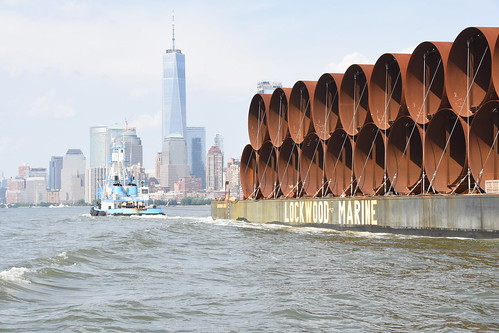FOR IMMEDIATE RELEASE 17-52 Shipment of Steel Liners Arrives for $1 Billion Delaware Aqueduct RepairBypass Tunnel is Largest Repair in the 175-Year History of NYC Water Supply SystemPhotos of the Steel Liners Traversing New York Harbor are Available on DEP’s Flickr PageThe New York City Department of Environmental Protection (DEP) last week received its sixth shipment of steel liners that will be used to repair the Delaware Aqueduct, the longest tunnel in the world. The massive liners were shipped by barge from Louisiana, traveling through New York Harbor and up the Hudson River to a port in Newburgh. The liners are part of a $1 billion project to fix two leaks within the 85-mile-long Delaware Aqueduct, which conveys about half of New York City’s drinking water each day from reservoirs in the Catskill Mountains. The project comprises the largest repair in the 175-year history of New York City’s water supply system. DEP is currently building a bypass tunnel alongside the largest leak in the Delaware Aqueduct. The 2.5-mile bypass will be constructed 600 feet below the Hudson River, between Newburgh and Wappinger. The finished bypass tunnel will be connected to structurally sound portions of the existing Delaware Aqueduct to convey water around the leaking section. The leaking stretch will then be plugged and permanently taken out of service. DEP expects to complete the project in 2023. Most of the Delaware Aqueduct was drilled through dense bedrock that provided support for the concrete tunnel. The portion underneath the Hudson River, however, was built through cracked and faulted limestone—a geology formation that lacked adequate support for the tunnel. When the aqueduct was built in the 1930s and 1940s, engineers provided structural support for this stretch of the tunnel by lining it with roughly 1,900 linear feet of steel. In the early 1990s, DEP discovered a leak coming from cracks that were located just outside the extent of that steel lining. The new bypass tunnel will eliminate those leaks and increase the extent of steel lining within the tunnel. Once it is finished, the bypass tunnel will be lined with 9,200 linear feet of steel to ensure its structural support extends beyond the limestone formation that contributed to the leak. Shipments of steel-liner segments began to arrive in Newburgh late in 2016. DEP has received six of 11 total shipments thus far. The 16-foot-diameter liner is comprised of 230 sections. Each segment measures 40 feet long and weighs approximately 80,000 pounds. DEP expects to begin drilling the bypass tunnel later this year. The steel liners will be set into place once the drilling is completed in 2019. The existing Delaware Aqueduct will stay in service while the bypass tunnel is built. In 2022, the aqueduct will be drained for the first time in 64 years, allowing construction workers to connect the bypass to structurally sound portions of the existing tunnel. At the same time, workers will enter a portion of the aqueduct in Ulster County to repair a second, small area of leakage from inside the tunnel. DEP manages New York City’s water supply, providing more than 1 billion gallons of high-quality water each day to more than 9.5 million New Yorkers. This includes more than 70 upstate communities and institutions in Ulster, Orange, Putnam and Westchester counties who consume an average of 110 million total gallons of drinking water daily from New York City’s water supply system. This water comes from the Catskill, Delaware, and Croton watersheds that extend more than 125 miles from the City, and the system comprises 19 reservoirs, three controlled lakes, and numerous tunnels and aqueducts. DEP has nearly 6,000 employees, including almost 1,000 scientists, engineers, surveyors, watershed maintainers and other professionals in the watershed. In addition to its $70 million payroll and $166 million in annual taxes paid in upstate counties, DEP has invested more than $1.7 billion in watershed protection programs—including partnership organizations such as the Catskill Watershed Corporation and the Watershed Agricultural Council—that support sustainable farming practices, environmentally sensitive economic development, and local economic opportunity. In addition, DEP has a robust capital program with $20.7 billion in investments planned over the next 10 years that will create up to 3,000 construction-related jobs per year. For more information, visit nyc.gov/dep, like us on Facebook, or follow us on Twitter. | ||
